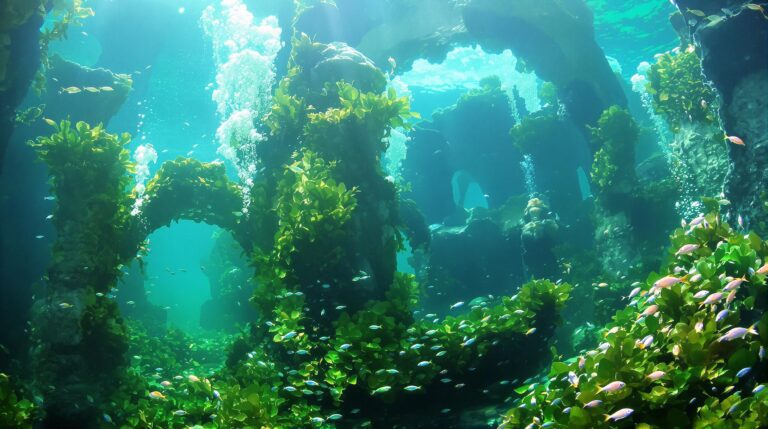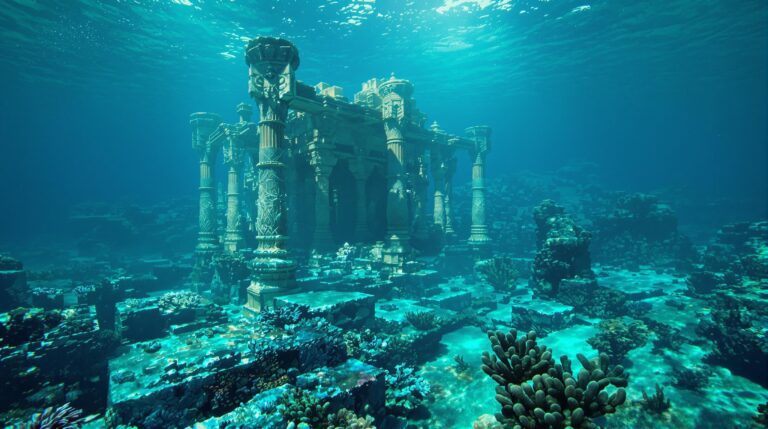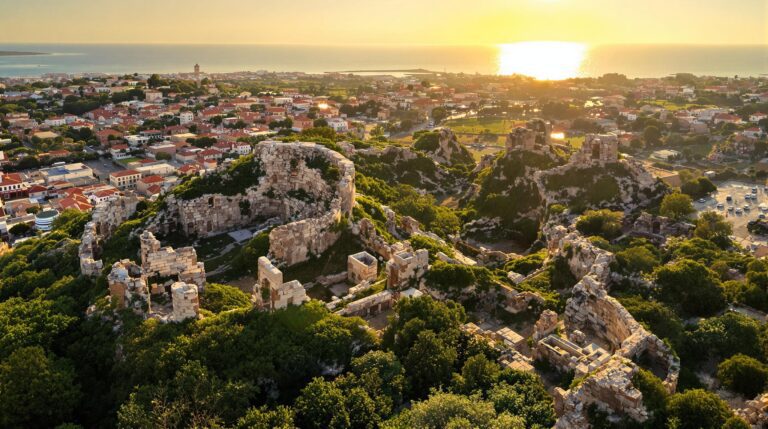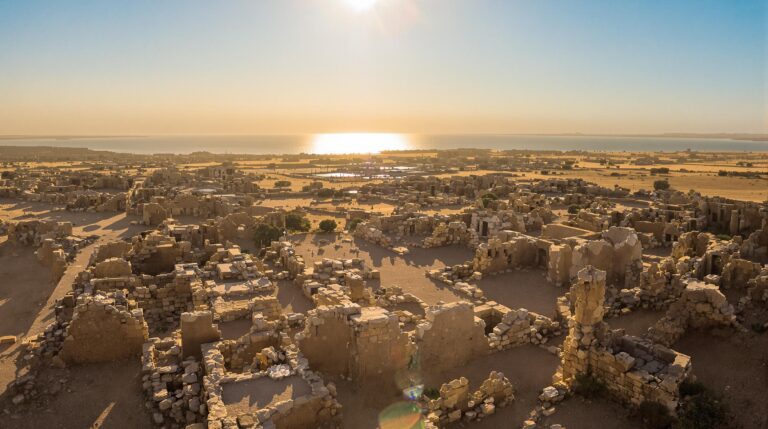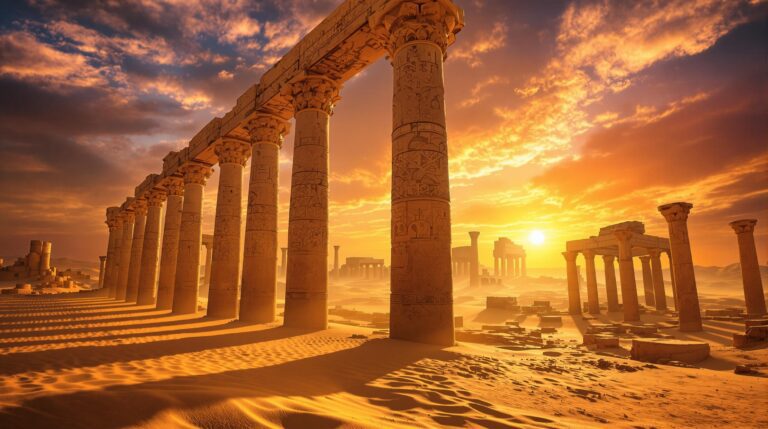Atlantis and the Richat Structure

The allure of Atlantis has captivated minds for centuries, sparking debates between myth and reality.
Meanwhile, the Richat Structure, with its mesmerizing circular form, stands as a geological puzzle in the heart of the Mauritanian desert.
Could this natural wonder be more than mere chance?
As ancient maps whisper secrets of alignment, one must ponder the deeper connections between these two enigmatic symbols. What truths might emerge from this intricate tapestry of history and legend?
TL;DR
Hide- The Richat Structure's circular formation resembles Plato's descriptions of Atlantis, inviting speculation on their possible connection.
- Historical maps suggest geographical alignments between the Richat Structure and the lost city of Atlantis, fostering intriguing parallels.
- Some theories propose that the Richat Structure could be a remnant of a lost civilization, echoing Atlantis's themes of grandeur and decay.
- Skepticism exists regarding the Atlantis-Richat connection, with scientific explanations attributing the structure's formation to natural geological processes.
- Both Atlantis and the Richat Structure inspire cultural narratives, reflecting humanity's quest for meaning and exploration of lost civilizations.
The Legend of Atlantis in Ancient Writings
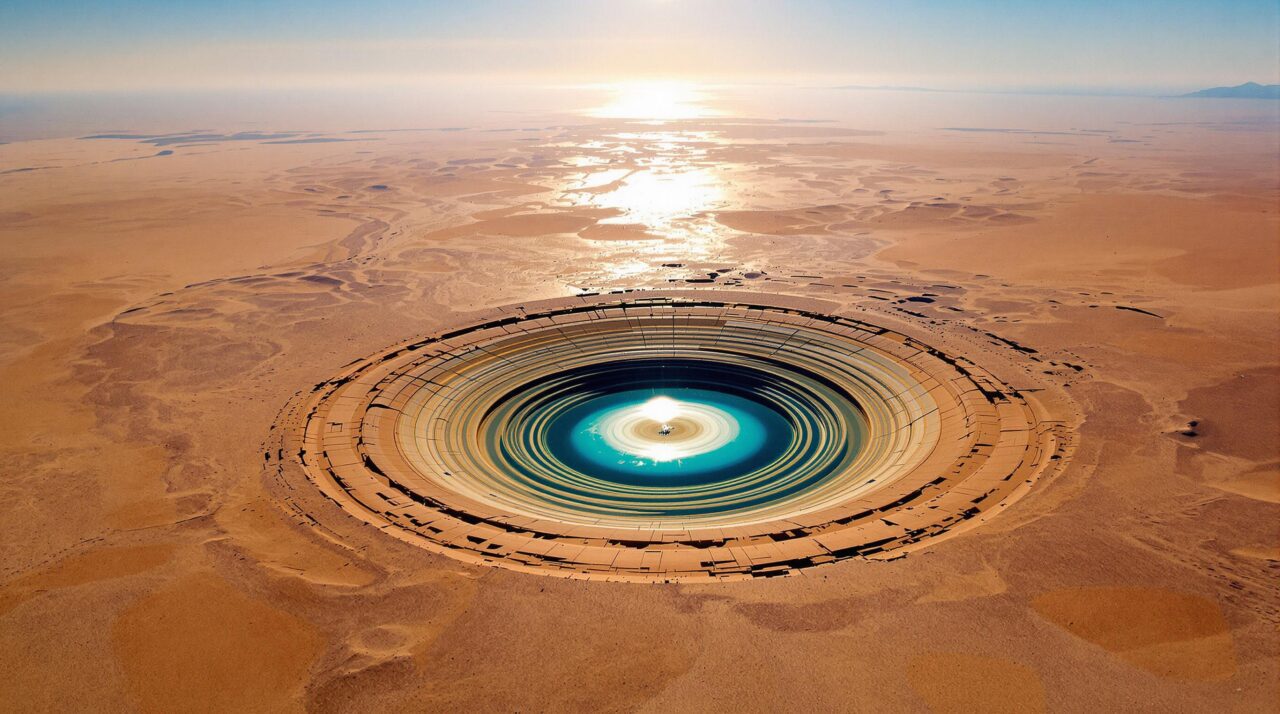
In the annals of ancient writings, Plato’s vivid portrayals of Atlantis beckon scholars to ponder their significance and truth.
The mythical elements woven into these narratives invite not only interpretation but also an exploration of the deeper symbolism that transcends time.
How might these tales, rich with allegory, mirror the human experience and the perennial quest for lost civilizations?
Plato’s Descriptions and Early Interpretations
In the dialogues of Timaeus and Critias, Plato paints a vivid tapestry of Atlantis, weaving together elements of grandeur and moral decay.
How have these ancient descriptions shaped the imagination of subsequent generations, transforming a seemingly lost civilization into a symbol of philosophical inquiry?
As echoes of Plato’s narrative ripple through Western thought, one must ponder the interpretations that have emerged, each adding layers to the legend’s enigmatic allure.
The Account of Atlantis in Timaeus and Critias
While the echoes of ancient wisdom resonate through time, the accounts of Atlantis as presented in Plato’s dialogues, Timaeus and Critias, emerge as a fascinating tapestry of myth and philosophy.
These texts weave together a narrative of a utopian civilization, rich in virtue yet doomed by hubris. Their exploration invites reflection on the nature of power, morality, and the fleeting essence of human ambition.
Subsequent Adaptations in Western Thought
As the narratives of Atlantis took root in the fertile grounds of Western thought, they transformed from mere philosophical musings into a complex tapestry of interpretations and adaptations.
Scholars and dreamers alike wove together tales of utopia and cautionary fables, questioning the essence of civilization. Each retelling sparked imaginations, beckoning humanity to ponder its own aspirations, failures, and the elusive promise of freedom.
Mythical Elements and Symbolism
In the shadowy corridors of ancient texts, themes of cataclysm and lost civilization swirl like mist, beckoning the curious mind to ponder their deeper meaning.
How does the tale of Atlantis, a lively society swallowed by the waves, resonate within the fabric of modern imagination?
This enigmatic narrative, rich with symbolism, invites exploration into humanity’s fears and aspirations, casting a long reflection on the nature of existence itself.
Themes of Cataclysm and Lost Civilization
Though often relegated to the domain of myth, the story of Atlantis embodies profound themes of cataclysm and the fragility of civilization.
This narrative invites reflection on humanity’s impermanence, urging an exploration of lost knowledge and warnings against hubris.
As civilizations rise and fall, the tale of Atlantis serves as a haunting reminder of the delicate balance between progress and destruction.
The Role of Atlantis in Modern Imagination
What images does the legend of Atlantis evoke in the modern imagination? It conjures visions of utopian societies, advanced technologies, and profound wisdom lost to time.
This mythical narrative dances between hope and despair, symbolizing humanity’s quest for enlightenment amidst chaos.
Atlantis serves as a mirror reflecting our desires for freedom, connection, and the eternal search for meaning in a transient world.
The Richat Structure: Nature’s Enigmatic Eye
The Richat Structure, often referred to as Nature’s Enigmatic Eye, captivates with its striking concentric circles, a geological marvel that beckons exploration of its origins.
What forces sculpted this eye-shaped formation in the heart of the Sahara, and what stories lie buried beneath its surface?
The interplay of geological processes and the myriad theories surrounding its creation invite both curiosity and contemplation.
Geological Formation and Characteristics
The Richat Structure, often likened to nature’s enigmatic eye, captivates with its striking circular design and vast expanse.
What forces of geological artistry have sculpted this unique formation, and how do its erosion patterns reveal the history of the Earth beneath?
A closer examination of its composition and size invites a deeper reflection on the mysteries held within this stunning landscape.
Composition, Size, and Erosion Patterns
Nature’s enigmatic eye, the Richat Structure, beckons intrigue with its distinctive geological features.
Composed primarily of sedimentary rocks, this colossal formation spans approximately 40 kilometers in diameter.
Erosion patterns reveal a history of relentless natural forces sculpting its surface, whispering tales of time.
The interplay of wind and water has etched a vivid narrative, inviting exploration and contemplation of its ancient secrets.
The Structure’s Remarkable Circular Design
An intriguing phenomenon, the Richat Structure captivates observers with its remarkable circular design, a feature that invites both scientific inquiry and artistic appreciation.
This geological marvel prompts reflection on its origins and significance. Key aspects include:
- Symmetry of the circles
- Geological layering
- Erosion patterns
- Visual allure
Such elements weave a narrative of nature’s artistry, echoing mysteries yet to be revealed.
Theories Behind Its Creation
The origins of the Richat Structure spark a fascinating debate between natural processes and the allure of extraordinary phenomena.
As one gazes upon its concentric circles, questions arise: Could this geological marvel be the result of erosion, or does it hint at something more enigmatic?
Comparative analysis with other geological wonders might illuminate its formation, yet the true story remains an invitation for exploration.
Natural Processes Versus Unusual Phenomena
While exploring the enigmatic Richat Structure, questions arise about its origins—were they shaped solely by natural processes, or do they hint at something more extraordinary?
The juxtaposition of nature’s artistry and potential otherworldly influence invites contemplation:
- Erosion patterns revealing time’s passage
- Geological formations shaped by ancient forces
- Unexplained alignments with celestial bodies
- Myths intertwining with earthly phenomena
Each element beckons inquiry.
Comparison with Other Geological Wonders
Although the Richat Structure captivates with its distinct circular form, comparisons with other geological wonders reveal a tapestry of earth’s complexities and mysteries.
From the majestic Grand Canyon to the enigmatic Moeraki Boulders, each formation tells a unique tale of time and transformation.
These natural marvels invite curiosity, urging exploration of the planet’s hidden narratives woven into its intricate geological fabric.
Linking Atlantis to the Richat Structure
The intriguing parallels between Atlantis and the Richat Structure beckon a closer examination of their potential connection.
Proponents argue that the structure’s circular formation and ancient lore resonate with Plato’s descriptions of the fabled city.
Yet, skepticism lingers, prompting a critical exploration of the evidence and the myths that intertwine these two enthralling narratives.
Arguments Supporting a Connection
The Richat Structure‘s circular form and concentric rings evoke the vivid imagery found in Plato’s descriptions of Atlantis, prompting a closer examination of these ancient narratives.
Interpretations of historical maps and clues suggest a geographical alignment that tantalizingly parallels the legendary lost city.
Could this enigmatic formation hold the key to revealing the mysteries of a civilization that has long since faded into myth?
Similarities to Plato’s Atlantis Descriptions
Connections between the Richat Structure and Plato’s descriptions of Atlantis spark an intriguing exploration into ancient narratives and geological formations.
The parallels are compelling:
- Concentric Circles: Both feature circular layouts.
- Natural Resources: Abundant mineral wealth described.
- Catastrophic Events: Accounts of sudden destruction resonate.
- Cultural Legacy: Both symbolize lost civilizations.
These elements invite deeper inquiry into the enigmatic tapestry of human history and myth.
Interpretations of Ancient Maps and Clues
While ancient maps often weave a narrative rich with mystery, their interpretations can reveal profound insights into the potential link between Atlantis and the Richat Structure.
Scholars ponder geographical anomalies and symbolic representations, seeking to decode these cartographic enigmas. Each line and contour whispers secrets of lost civilizations, inviting the curious to explore the depths of history and the possibility of forgotten domains.
Counterarguments and Skepticism
As whispers of Atlantis intertwine with the enigmatic Richat Structure, skepticism blooms in the shadows.
Scientific explanations suggest natural origins, while alternative theories vie for attention amid ongoing debates.
What, then, is the truth hidden beneath layers of myth and geology?
Scientific Explanations for the Structure’s Formation
Although theories abound regarding the origins of the Richat Structure, known for its striking circular form in the Mauritanian desert, scientific explanations often diverge from the romantic notion of Atlantis.
Scholars propose several hypotheses:
- Erosion of softer rock layers.
- Geological uplift and subsequent weathering.
- Impact of ancient volcanic activity.
- Circular sedimentary deposition.
These interpretations invite wonder, yet they ground the enigmatic in reality.
Alternative Theories and Ongoing Debates
Despite the allure of equating the Richat Structure with the legendary Atlantis, skeptics raise significant counterarguments that challenge this romantic narrative.
They question the geographical discrepancies and historical timelines, suggesting instead that the structure is merely a geological phenomenon.
Such skepticism invites a deeper exploration of human imagination, where myths and realities intertwine, urging seekers of truth to tread carefully in the sands of speculation.
Modern Research and Technological Advances
Modern research, illuminated by the brilliance of remote sensing and satellite imaging, beckons a new understanding of the Richat Structure‘s enigmatic form.
As archaeologists and geophysicists employ innovative techniques to unearth hidden narratives beneath the surface, questions arise about the very essence of what lies beneath, possibly echoing tales of Atlantis.
Might these technological advances not only reshape the landscape of knowledge but also redefine humanity’s connection to ancient myths?
Remote Sensing and Satellite Imaging
In the domain of modern exploration, the Richat Structure emerges as a canvas for 3D mapping, inviting scrutiny through the lens of remote sensing and satellite imaging.
Recent discoveries unfold like chapters in an ancient tale, revealing layers of complexity that beckon for thorough analysis.
What secrets might this geological marvel still hold, waiting for the touch of technology to illuminate its past?
3D Mapping of the Richat Structure
As researchers explore the enigmatic contours of the Richat Structure, they find themselves equipped with advanced tools that revolutionize the way landscapes are mapped and understood.
Through this technological lens, they uncover:
- Geological formations and anomalies
- Historical topographical changes
- Environmental impact assessments
- Patterns of erosion and sedimentation
Such insights illuminate the mysteries beneath, inviting a deeper connection to this ancient marvel.
Recent Discoveries and Data Analysis
Advancements in remote sensing and satellite imaging have opened new avenues for understanding the Richat Structure, revealing its intricate layers with unprecedented clarity.
These modern technologies invite a deeper exploration of geological formations, prompting questions about their origins and histories.
As researchers analyze the data, they weave a narrative, illuminating the mysteries of this enigmatic site, forever tantalizing the quest for knowledge and freedom within the domains of science.
Archaeological and Geophysical Investigations
In the sweeping expanse of the Sahara Desert, field studies emerge as a tapestry of inquiry, weaving together the threads of past and present.
Collaborative efforts among archaeologists and geophysicists illuminate the shadows of history, inviting contemplation on the enigma of lost civilizations.
As modern technologies chart the unseen, one wonders what secrets lie beneath the surface, waiting to be uncovered.
Field Studies in the Sahara Desert
While the Sahara Desert stretches vast and enigmatic, it beckons modern researchers to explore beneath its parched surface, where history whispers through the sands.
Field studies illuminate the desert’s secrets through:
- Remote sensing technologies
- Ground-penetrating radar
- Satellite imagery analysis
- Geochemical sampling
These tools reveal ancient landscapes, inviting a deeper understanding of civilizations lost to time, and the ever-elusive Atlantis.
Collaborative Efforts to Unravel Historical Mysteries
How do modern collaborations among archaeologists, geophysicists, and historians reshape the quest for understanding ancient mysteries?
By merging diverse expertise, they illuminate hidden truths beneath the sands of time.
Cutting-edge technologies like ground-penetrating radar reveal secrets long buried, while interdisciplinary dialogues breathe life into forgotten narratives.
Together, they forge pathways to knowledge, inviting humanity to rediscover its past with a spirit of exploration and wonder.
Cultural Impact and Enduring Mystique
The allure of Atlantis has woven itself into the fabric of literature and popular culture, igniting imaginations through countless narratives and artistic expressions.
What legacy does this fabled civilization hold in contemporary discourse, shaping perceptions of lost worlds and human aspirations?
As the Richat Structure stands sentinel in the desert, it beckons a reflection on how myths endure and transform, echoing across time and thought.
Influence on Literature and Pop Culture
The Richat Structure, often whispered about in the same breath as Atlantis, has inspired a myriad of depictions in literature and cinema, each reflecting humanity’s fascination with lost civilizations.
What draws storytellers to this enigmatic formation, transforming it into a symbol of forgotten grandeur and rebirth?
Through the lens of myth, the allure of a vanished empire continues to resonate, inviting exploration of its cultural significance in the collective imagination.
Depictions in Movies, Books, and Documentaries
What is it about the lost city of Atlantis that continues to captivate the imagination of storytellers and filmmakers alike? This ancient enigma has inspired a myriad of interpretations:
- Epic Films: Grand narratives exploring civilization and downfall.
- Fantasy Novels: Rich tales of exploration and adventure.
- Documentaries: Analytical dives into history and myth.
- Animated Series: Whimsical interpretations for younger audiences.
Each medium breathes new life into the legend.
The Symbolism of a Lost Empire Reborn in Myth
Mystique surrounds the lost city of Atlantis, embodying the allure of a vanished empire that continues to resonate across cultures and eras.
Its symbolism transcends time, inviting exploration of humanity’s aspirations and failures.
In literature and pop culture, Atlantis serves as a canvas for dreams of utopia and cautionary tales, reflecting the eternal quest for identity, belonging, and the freedom to imagine beyond the horizon.
The Legacy of Atlantis in Modern Discourse
The enigma of Atlantis continues to captivate scholars and dreamers alike, igniting a fervent debate that transcends time and discipline.
How does this ancient tale influence contemporary understandings of civilization, myth, and human aspiration?
As the discourse evolves, it beckons a reevaluation of not only our past but also the narratives we construct around our collective identity.
Continued Fascination and Academic Interest
As scholars and enthusiasts explore the depths of myth and history, the legend of Atlantis remains an intriguing subject that transcends time and culture.
Its enduring mystique is fueled by:
- Compelling narratives of advanced civilizations.
- The quest for lost knowledge and wisdom.
- Symbolism in art and literature.
- Modern archaeological pursuits igniting curiosity.
Together, these elements foster a continuous exploration of humanity’s deepest questions.
How the Debate Shapes Our Understanding of the Past
Though often dismissed as mere legend, the debate surrounding Atlantis invites a profound examination of how myths can shape cultural narratives and collective identities.
Through the lens of Atlantis, societies reflect on their values, aspirations, and fears. This enduring mystique fosters a dialogue about civilization’s potential and pitfalls, urging humanity to explore the depths of history, imagination, and the uncharted waters of existence.
Wrapping Up
As the enigma of Atlantis continues to captivate imaginations, the Richat Structure stands as a tangible monument to humanity’s enduring quest for lost legends.
With over 100,000 visitors drawn to its mesmerizing forms each year, the interplay between myth and reality remains a compelling narrative.
What secrets linger within the depths of such geological wonders?
The search for understanding transcends time, inviting all to ponder the intricate tapestry of our shared history and the civilizations that once thrived.
